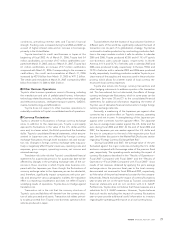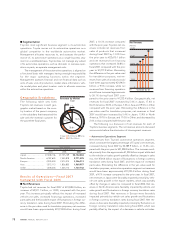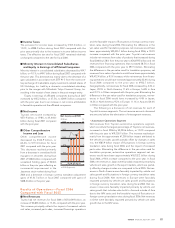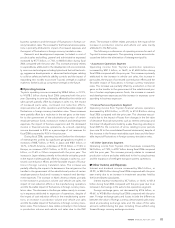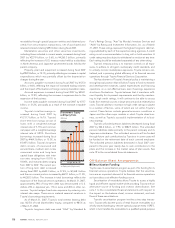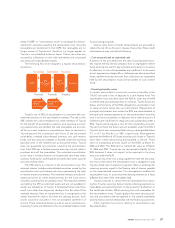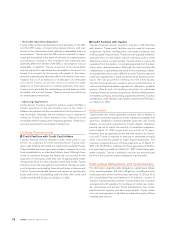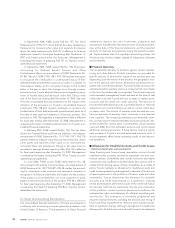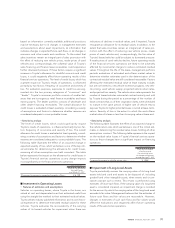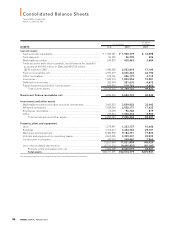Toyota 2007 Annual Report Download - page 86
Download and view the complete annual report
Please find page 86 of the 2007 Toyota annual report below. You can navigate through the pages in the report by either clicking on the pages listed below, or by using the keyword search tool below to find specific information within the annual report.
84 ANNUAL REPORT 2007
Other income, net increased by ¥113.4 billion, or 10.1 times,
to ¥125.8 billion during fiscal 2006. This increase primarily relates
to the gain of ¥143.3 billion for a nonmonetary exchange of mar-
ketable equity securities.
■Income Taxes
The provision for income taxes increased by ¥137.2 billion, or
20.9%, to ¥795.1 billion during fiscal 2006 compared with the
prior year primarily due to the increase in income before income
taxes. The effective tax rate for fiscal 2006 was relatively
unchanged compared to the rate for fiscal 2005.
■Minority Interest in Consolidated Subsidiaries
and Equity in Earnings of Affiliated Companies
Minority interest in consolidated subsidiaries increased by ¥19.5
billion, or 30.0%, to ¥84.4 billion during fiscal 2006 compared with
the prior year. This increase was mainly due to favorable operat-
ing results at consolidated subsidiaries and a gain calculated in
accordance with EITF 91-5 from the nonmonetary exchange of
marketable equity investments related shares of UFJ Holdings,
Inc. held by a domestic consolidated subsidiary prior to the
merger with Mitsubishi Tokyo Financial Group, Inc. resulting in
the receipt of new shares in the post-merger entity.
Equity in earnings of affiliated companies during fiscal 2006
increased by ¥24.9 billion, or 17.8%, to ¥164.3 billion compared
with the prior year due to an increase in net income attributable
to favorable operations at the affiliated companies.
■Net Income
Toyota’s net income increased by ¥200.9 billion, or 17.2%, to
¥1,372.1 billion during fiscal 2006 compared with the prior year.
■Other Comprehensive Income and Loss
Other comprehensive income increased by ¥394.0 billion, or 4.2
times, to ¥517.9 billion for fiscal 2006 compared with the prior
year. This increase resulted primarily from an increase in unreal-
ized holding gains on securities during fiscal 2006 of ¥244.6 bil-
lion compared with unrealized holding gains of ¥38.4 billion in
the prior year reflecting the improvement in the Japanese stock
market and foreign currency translation adjustment gains of
¥268.4 billion in fiscal 2006 compared with gains of ¥75.7 billion in
the prior year. These increases in other comprehensive income
were partially offset by the lower gain adjustment in the minimum
pension liability component during fiscal 2006 of ¥4.9 billion com-
pared to a ¥9.8 billion gain adjustment in the prior year.
Outlook
Toyota expects that the global economy will grow moderately in
fiscal 2008, despite factors such as concerns about the U.S. eco-
nomic trend, changes in the pace of growth of the Chinese
economy, and oil price trend. Toyota expects that the global
automotive markets will remain at the same level as fiscal 2007.
Toyota, for the purposes of this discussion, is assuming an average
exchange rate of ¥115 to the U.S. dollar and ¥150 to the euro.
With these external factors in mind, Toyota expects that net rev-
enues for fiscal 2008 will increase compared with fiscal 2007 as a
result of expected increase in vehicle unit sales primarily in Other
and Asia. Sales efforts are expected to increase vehicle unit sales
and, together with cost reduction efforts, increase operating
income. On the other hand, the assumed exchange rate of a
slightly stronger yen against the U.S. dollar, the anticipated
increases in depreciation expenses resulting from active capital
expenditures, and expenditures relating to the research and
development of environmental technology such as hybrid vehi-
cles and fuel cell, safety technology and other next-generation
technologies are expected to be offsetting factors. In addition,
the effects of cost reduction efforts may be influenced by fluctua-
tions in the prices of raw materials. As a result, Toyota expects
that operating income will remain relatively unchanged in fiscal
2008 compared with fiscal 2007. Also, Toyota expects that
income before income taxes, minority interest and equity in earn-
ings of affiliated companies and net income will remain generally
unchanged in fiscal 2008. Exchange rate fluctuations can also
materially affect Toyota’s operating results. In particular, a
strengthening of the Japanese yen against the U.S. dollar can
have a material adverse effect on Toyota’s operating results.
Please see “Operating and Financial Review and Prospects—
Operating Results—Overview—Currency Fluctuations”.
The foregoing statements are forward-looking statements
based upon Toyota’s management’s assumptions and beliefs
regarding exchange rates, market demand for Toyota’s products,
economic conditions and others. Please see “Cautionary
Statement with Respect to Forward-Looking Statements”.
Toyota’s actual results of operations could vary significantly from
those described above as a result of unanticipated changes in
the factors described above or other factors, including those
described “Risk Factors”.
Liquidity and Capital Resources
Historically, Toyota has funded its capital expenditures and
research and development activities primarily through cash gen-
erated by operations.
Toyota expects to sufficiently fund its capital expenditures
and research and development activities in fiscal 2008 primarily
through cash and cash equivalents on hand and increases in cash
and cash equivalents from operating activities. See “Information
on the Company—Business Overview—Capital Expenditures
and Divestitures” for information regarding Toyota’s material
capital expenditures and divestitures for fiscal 2005, 2006 and
2007 and information concerning Toyota’s principal capital
expenditures and divestitures currently in progress.
Toyota funds its financing programs for customers and deal-
ers, including loans and leasing programs, from both operating
cash flows and borrowings by its finance subsidiaries. Toyota seeks
to expand its ability to raise funds locally in markets throughout
the world by expanding its network of finance subsidiaries.





